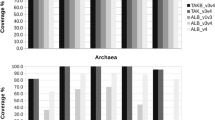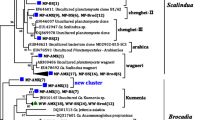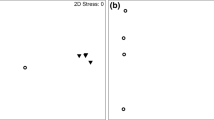Abstract
16S ribosomal RNA gene sequences are characteristically used as gold-standard genetic marker for the determination of bacterial and/or archaeal biodiversity, and community profiling of environmental samples. The 16S rRNA amplicon analysis till-date is taken as a standard method for investigation and identification of uncultivable bacteria in microbial diversity studies. The accuracy of these analyses strongly depends upon the choice of primers. It is presumed that these primers do not participate in non-specific amplifications. In the present study, by in silico, PCR and denaturing gradient gel electrophoresis (DGGE) analysis, we have shown that primers do cross-react with eukaryotic DNAs as well, eventually leading to overestimation of microbial biodiversity. We further demonstrated that the overestimation is not only due to cross-reaction with eukaryotic mitochondrial or plastid DNA, but also with eukaryotic chromosomal DNA, that is ubiquitous in environmental samples. We tried to establish methanogenic diversity in municipal solid waste (MSW) leachates and cow dung samples before and after enrichment of the prokaryotic DNA from eukaryotic ones. Results revealed that bands disappeared/get lightened in bacterial 16S rRNA-based DGGE community profiles, after prokaryotic DNA enrichment, but not in mcrA-based community profiles.






Similar content being viewed by others
References
Altschul SF, Gish W, Miller W et al (1990) Basic local alignment search tool. J Mol Biol 215:403–410. https://doi.org/10.1016/S0022-2836(05)80360-2
Altschul SF, Madden TL, Schäffer AA et al (1997) Gapped BLAST and PSI-BLAST: a new generation of protein database search programs. Nucleic Acids Res 25:3389–3402
Amann RI, Ludwig W, Schleifer KH (1995) Phylogenetic identification and in situ detection of individual microbial cells without cultivation. Microbiol Rev 59:143–169
Ampe F, Miambi E (2000) Cluster analysis, richness and biodiversity indexes derived from denaturing gradient gel electrophoresis fingerprints of bacterial communities demonstrate that traditional maize fermentations are driven by the transformation process. Int J Food Microbiol 60:91–97. https://doi.org/10.1016/S0168-1605(00)00358-5
Bardgett RD, van der Putten WH (2014) Belowground biodiversity and ecosystem functioning. Nature 515:505–511. https://doi.org/10.1038/nature13855
Bikandi J, San Millán R, Rementeria A, Garaizar J (2004) In silico analysis of complete bacterial genomes: PCR, AFLP-PCR and endonuclease restriction. Bioinformatics 20:798–799. https://doi.org/10.1093/bioinformatics/btg491
Bodelier PL, Meima-Franke M, Zwart G, Laanbroek JH (2017) New DGGE strategies for the analyses of methanotrophic microbial communities using different combinations of existing 16S rRNA-based primers. FEMS Microbiol Ecol. https://doi.org/10.1016/j.femsec.2004.11.004/full
Calabrese FM, Simone D, Attimonelli M (2012) Primates and mouse NumtS in the UCSC Genome Browser. BMC Bioinform 13:S15. https://doi.org/10.1186/1471-2105-13-S4-S15
Case RJ, Boucher Y, Dahllöf I et al (2007) Use of 16S rRNA and rpoB genes as molecular markers for microbial ecology studies. Appl Environ Microbiol 73:278–288. https://doi.org/10.1128/AEM.01177-06
Choi Y-J, Beakes G, Glockling S et al (2015) Towards a universal barcode of oomycetes—a comparison of the cox1 and cox2 loci. Mol Ecol Resour 15:1275–1288. https://doi.org/10.1111/1755-0998.12398
Dollive S (2013) Dynamics of microeukaryotes and archaea in the mammalian gut microbiome. University of Pennsylvania, Pennsylvania
Ercolini D (2004) PCR-DGGE fingerprinting: novel strategies for detection of microbes in food. J Microbiol Methods 56:297–314. https://doi.org/10.1016/j.mimet.2003.11.006
Feehery GR, Yigit E, Oyola SO et al (2013) A method for selectively enriching microbial DNA from contaminating vertebrate host DNA. PLoS ONE 8:e76096. https://doi.org/10.1371/journal.pone.0076096
Gabor EM, de Vries EJ, Janssen DB (2003) Efficient recovery of environmental DNA for expression cloning by indirect extraction methods. FEMS Microbiol Ecol 44:153–163. https://doi.org/10.1016/S0168-6496(02)00462-2
Galkiewicz JP, Kellogg CA (2008) Cross-Kingdom amplification using Bacteria-specific primers: complications for studies of Coral microbial ecology. Appl Environ Microbiol 74:7828–7831. https://doi.org/10.1128/AEM.01303-08
Green SJ, Leigh MB, Neufeld JD (2010) Denaturing gradient gel electrophoresis (DGGE) for microbial community analysis. In: Timmis KN (ed) Handbook of hydrocarbon and lipid microbiology. Springer, Berlin, pp 4137–4158
Kommedal Ø, Simmon K, Karaca D et al (2012) Dual priming oligonucleotides for broad-range amplification of the bacterial 16S rRNA gene directly from human clinical specimens. J Clin Microbiol 50:1289–1294. https://doi.org/10.1128/JCM.06269-11
Hanshew AS, Mason CJ, Raffa KF, Currie CR (2013) Minimization of chloroplast contamination in 16S rRNA gene pyrosequencing of insect herbivore bacterial communities. J Microbiol Methods 95:149–155. https://doi.org/10.1016/j.mimet.2013.08.007
Hugenholtz P, Tyson GW (2008) Microbiology: metagenomics. Nature 455:481–483
Huws SA, Edwards JE, Kim EJ, Scollan ND (2007) Specificity and sensitivity of eubacterial primers utilized for molecular profiling of bacteria within complex microbial ecosystems. J Microbiol Methods 70:565–569. https://doi.org/10.1016/j.mimet.2007.06.013
Huys G, Vanhoutte T, Joossens M et al (2008) Coamplification of eukaryotic DNA with 16S rRNA gene-based PCR primers: possible consequences for population fingerprinting of complex microbial communities. Curr Microbiol 56:553–557. https://doi.org/10.1007/s00284-008-9122-z
Ikenaga M, Asakawa S, Muraoka Y, Kimura M (2004) Methanogenic archaeal communities in rice roots grown in flooded soil pots: estimation by PCR-DGGE and sequence analyses. Soil Sci Plant Nutr 50:701–711. https://doi.org/10.1080/00380768.2004.10408526
Kimura M (1980) A simple method for estimating evolutionary rates of base substitutions through comparative studies of nucleotide sequences. J Mol Evol 16:111–120
Lane D (1991) 16S/23S rRNA sequencing. In: Stackebrandt E, Goodfellow M (eds) Nucleic acid techniques in bacterial systematic. Wiley, New York, pp 115–175
Niemi RM, Heiskanen I, Wallenius K, Lindström K (2001) Extraction and purification of DNA in rhizosphere soil samples for PCR-DGGE analysis of bacterial consortia. J Microbiol Methods 45:155–165
Maitra S, Kumar B, Kumar S et al (2015) Coss-reactivity of prokaryotic 16S rRNA gene-specific primers with genomes from eukaryotic organisms from marshlands. J Biol Nat 2:56–68
Mori H, Maruyama F, Kato H et al (2014) Design and experimental application of a novel non-degenerate universal primer set that amplifies prokaryotic 16S rRNA genes with a low possibility to amplify eukaryotic rRNA genes. DNA Res 21:217–227. https://doi.org/10.1093/dnares/dst052
Muyzer G (1999) DGGE/TGGE a method for identifying genes from natural ecosystems. Curr Opin Microbiol 2:317–322. https://doi.org/10.1016/S1369-5274(99)80055-1
Nocker A, Burr M, Camper AK (2007) Genotypic microbial community profiling: a critical technical review. Microb Ecol 54:276–289. https://doi.org/10.1007/s00248-006-9199-5
Olsen GJ, Woese CR (1993) Ribosomal RNA: a key to phylogeny. FASEB J 7:113–123
Pace N (1996) New perspective on the natural microbial world: molecular microbial ecology. ASM News 62:463–470
Pace NR (1997) A molecular view of microbial diversity and the biosphere. Science 276:734–740
Rajendhran J, Gunasekaran P (2011) Microbial phylogeny and diversity: small subunit ribosomal RNA sequence analysis and beyond. Microbiol Res 166:99–110. https://doi.org/10.1016/j.micres.2010.02.003
Schloss PD, Gevers D, Westcott SL (2011) Reducing the effects of PCR amplification and sequencing artifacts on 16S rRNA-based studies. PLOS ONE 6:e27310. https://doi.org/10.1371/journal.pone.0027310
Schuler GD (1997) Sequence mapping by electronic PCR. Genome Res 7:541–550. https://doi.org/10.1101/gr.7.5.541
Sergeant MJ, Constantinidou C, Cogan T et al (2012) High-throughput sequencing of 16S rRNA gene amplicons: effects of extraction procedure, primer length and annealing temperature. PLOS ONE 7:e38094. https://doi.org/10.1371/journal.pone.0038094
Sipos R, Székely AJ, Palatinszky M et al (2007) Effect of primer mismatch, annealing temperature and PCR cycle number on 16S rRNA gene-targeting bacterial community analysis. FEMS Microbiol Ecol 60:341–350. https://doi.org/10.1111/j.1574-6941.2007.00283.x
Taberlet P, Coissac E, Hajibabaei M, Rieseberg LH (2012) Environmental DNA. Mol Ecol 21:1789–1793. https://doi.org/10.1111/j.1365-294X.2012.05542.x
Tamura K, Stecher G, Peterson D et al (2013) MEGA6: molecular evolutionary genetics analysis version 6.0. Mol Biol Evol 30:2725–2729. https://doi.org/10.1093/molbev/mst197
Thomsen PF, Willerslev E (2015) Environmental DNA—an emerging tool in conservation for monitoring past and present biodiversity. Biol Conserv 183:4–18. https://doi.org/10.1016/j.biocon.2014.11.019
Timmis JN, Ayliffe MA, Huang CY, Martin W (2004) Endosymbiotic gene transfer: organelle genomes forge eukaryotic chromosomes. Nat Rev Genet 5:123–135. https://doi.org/10.1038/nrg1271
von Wintzingerode F, Göbel UB, Stackebrandt E (1997) Determination of microbial diversity in environmental samples: pitfalls of PCR-based rRNA analysis. FEMS Microbiol Rev 21:213–229
Yadav S, Kundu S, Ghosh SK, Maitra SS (2015) Molecular analysis of methanogen richness in landfill and marshland targeting 16S rDNA sequences. In: Archaea. https://www.hindawi.com/journals/archaea/2015/563414/. Accessed 19 Sep 2017
Acknowledgements
SSM is indebted to Jawaharlal Nehru University and PURSE program of Department of Science and Technology (DST) for funding. AK was supported by National Postdoctoral Fellowship funded by Science & Engineering Research Board (SERB), Govt. of India [Award No. PDF/2015/000474].
Author information
Authors and Affiliations
Corresponding author
Ethics declarations
Conflict of interest
The authors have no conflicting interests.
Electronic Supplementary material
Below is the link to the electronic supplementary material.
Rights and permissions
About this article
Cite this article
Yadav, S., Kumar, A., Gupta, M. et al. Cross-Reactivity of Prokaryotic 16S rDNA-Specific Primers to Eukaryotic DNA: Mistaken Microbial Community Profiling in Environmental Samples. Curr Microbiol 75, 1038–1045 (2018). https://doi.org/10.1007/s00284-018-1482-4
Received:
Accepted:
Published:
Issue Date:
DOI: https://doi.org/10.1007/s00284-018-1482-4




